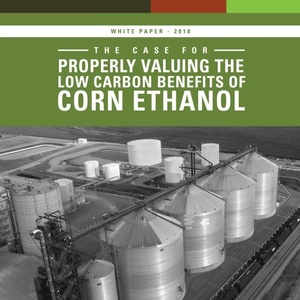ACE releases white paper on low carbon benefits of corn ethanol

American Coalition for Ethanol
August 17, 2018
BY American Coalition for Ethanol
The American Coalition for Ethanol announced the official release of a white paper today entitled “The Case for Properly Valuing the Low Carbon Benefits of Corn Ethanol,” coinciding with a general session panel at the 31st annual ACE conference in Minneapolis, which highlighted the paper in a discussion on updates to lifecycle modeling and opportunities on the horizon for ethanol as a low carbon fuel.
The Renewable Fuel Standard was enacted, in part, to drive innovation and production of low carbon biofuels that reduce greenhouse gas (GHG) emissions and as a result the program has successfully replaced 10 percent of petroleum in the U.S. transportation fleet with carbon-friendly fuel. However, the EPA has yet to update its original corn ethanol GHG assessments from when the RFS was enacted over a decade ago to reflect today’s significant GHG reduction benefits.
“The ACE White Paper makes a compelling case that lifecycle GHG modeling must reflect the latest science if low carbon fuel programs are to achieve their desired results,” said Brendan Jordan, vice president of the Great Plains Institute. “The Great Plains Institute agrees there is a huge opportunity for existing corn ethanol plants to lower their carbon footprint through innovative technology and updated lifecycle modeling. We’re just beginning to see the potential for environmental improvements through carbon capture and storage, soil carbon and agronomy, and plant efficiencies. The ACE White Paper makes an important contribution toward making progress on these goals.”
Advertisement
Advertisement
Jordan joined Bill Hohenstein, acting director of the Office of Energy Policy and New Uses within the Office of the Chief Economist, USDA; and Ron Alverson, member of ACE’s Board of Directors representing Dakota Ethanol and a chief contributor to the White Paper, on the panel moderated by ACE CEO Brian Jennings.
“Since the direct effects on soil carbon stocks of each biofuel feedstock crop can have a very large impact on carbon intensity, it is crucial that this accounting is included in the modeling,” Alverson said. “The trend is biofuel’s friend—petroleum-based transportation fuel lifecycle GHGs continue to rise and biofuel lifecycle GHGs continue to improve.”
Advertisement
Advertisement
“It’s ACE’s hope that our White Paper will build consensus for recognizing the significant climate benefits from further expansion of corn ethanol production and us in the U.S. beyond volumes called for in the RFS,” Jennings said. “We intend for the White Paper to inform stakeholders and policymakers at the state and federal level as they consider changes to existing low carbon fuel programs or the adoption of new clean fuel initiatives in the future.”
The full White Paper is published here: https://ethanol.org/ethanol-essentials/low-carbon-benefits-of-corn-ethanol.
Related Stories
The U.S. Energy Information Administration maintained its forecast for 2025 and 2026 biodiesel, renewable diesel and sustainable aviation fuel (SAF) production in its latest Short-Term Energy Outlook, released July 8.
XCF Global Inc. on July 10 shared its strategic plan to invest close to $1 billion in developing a network of SAF production facilities, expanding its U.S. footprint, and advancing its international growth strategy.
U.S. fuel ethanol capacity fell slightly in April, while biodiesel and renewable diesel capacity held steady, according to data released by the U.S. EIA on June 30. Feedstock consumption was down when compared to the previous month.
XCF Global Inc. on July 8 provided a production update on its flagship New Rise Reno facility, underscoring that the plant has successfully produced SAF, renewable diesel, and renewable naphtha during its initial ramp-up.
The U.S. EPA on July 8 hosted virtual public hearing to gather input on the agency’s recently released proposed rule to set 2026 and 2027 RFS RVOs. Members of the biofuel industry were among those to offer testimony during the event.
Upcoming Events










